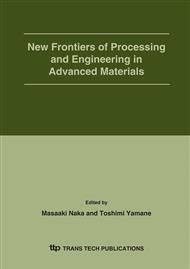[1]
H. Kusamichi, Titanium Metal and its Application (in Japanese), Tokyo: Nikkan Kogyo Shinbun-sha, 42-45, (1983).
Google Scholar
[2]
A. Kobayashi, New Applied Technology of Plasma Heat Source, Weld. International, 4, No. 4, 276-282, (1990).
Google Scholar
[3]
A. Kobayashi, Surface Nitridation of Titanium Alloy by Means of Gas Tunnel Type Plasma Jet (in Japanese), Applied Plasma Science, Dec., Vol. 3, 25-32, (1995).
Google Scholar
[4]
A. Kobayashi, Surface Nitridation of Titanium Metals by Means of Gas Tunnel Type Plasma Jet, J. Mater. Eng. & Performance, 5-3, 373-380, (1996).
DOI: 10.1007/bf02649339
Google Scholar
[5]
Y. Arata and A. Kobayashi, Development of Gas Tunnel Type High Power Plasma Jet (in Japanese), J. High Temp. Soc., 11-3, 124-131, (1985).
Google Scholar
[6]
Y. Arata and A. Kobayashi, Application of gas tunnel to high-energy-density plasma beams, J. Appl. Phys., Vol. 59, No. 9, pp.3038-3044, (1986).
DOI: 10.1063/1.337047
Google Scholar
[7]
Y. Arata, A. Kobayashi and Y. Habara, Basic Characteristics of Gas Tunnel Type Plasma Jet Torch, Jpn.J. Appl. Phys., 25-11, 1697-1701, (1986).
DOI: 10.1143/jjap.25.1697
Google Scholar
[8]
M. Okada and Y. Arata, Plasma Engineering (in Japanese), Tokyo: Nikkan Kogyo Shinbun-sha, (1965).
Google Scholar
[9]
Y. Arata and A. Kobayashi, and Y. Habara, Ceramic coatings produced by means of a gas tunnel type plasma jet, J. Appl. Phys., 62-12, 4884-4889, (1987).
DOI: 10.1063/1.338995
Google Scholar
[10]
Y. Arata and A. Kobayashi, and S. Kurihara, Effects of Spraying Conditions in Gas Tunnel Type Plasma Spraying (in Japanese), J. High Temp. Soc., 15-5, 210-216, (1989).
Google Scholar
[11]
A. Kobayashi, Property of an Alumina Coating Sprayed with a Gas Tunnel Plasma Spraying, Proc. of ITSC., 57-62, (1992).
Google Scholar
[12]
A. Kobayashi; Formation of High Hardness Zirconia Coatings by Gas Tunnel Type Plasma Spraying, Surface and Coating Technology, Vol. 90, pp.197-202, (1990).
DOI: 10.1016/s0257-8972(96)03143-x
Google Scholar
[13]
S. Sampath, R. Gansert, H. Herman, JOM 47-10, pp.30-33, (1995).
Google Scholar
[14]
A. Kobayashi, Formation of Functionally Graded Zirconia Composite Coating by Gas Tunnel Type Plasma Spraying (in Japanese), Applied Plasma Science, Dec., Vol. 10, 96-101, (2002).
Google Scholar
[15]
A. Kobayashi, Ceramic Composite Coating by Gas Tunnel Type Plasma Spraying for High Performance TBC" , Proc. of DIS , 02., 769-774, (2002).
Google Scholar
[16]
S. Dai, J-P. Delplanque, R.H. Rangel, E.J. Lavernia, Modeling of Reactive Spray Atomization and Deposition, Proc. of International Thermal Spray Conference, Vol. 1, pp.341-346, (1998).
DOI: 10.31399/asm.cp.itsc1998p0341
Google Scholar
[17]
O. Al-Sabouni, D.J. Stephenson, J.R. Nicholls, Reactive Plasma of 80: 20 Ni/Cr and McrAlY Powders with Hydrocarbon Reactive Gases, Proc. of International Thermal Spray Conference, Vol. 2, pp.1315-1320, (1998).
DOI: 10.31399/asm.cp.itsc1998p1315
Google Scholar
[18]
A. Kobayashi, Study on the Formation of TiN Coating by Plasma Reactive Spraying (in Japanese), Plasma Application & Hybrid Functionally Materials, Vol. 6, March pp.71-74, (1997).
Google Scholar
[19]
A. Kobayashi, Properties of Gas Tunnel Plasma Reactive Spraying(in Japanese), Plasma Application & Hybrid functionally Materials, 7, 103-106, (1998).
Google Scholar


